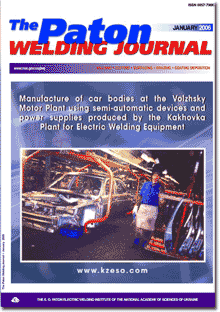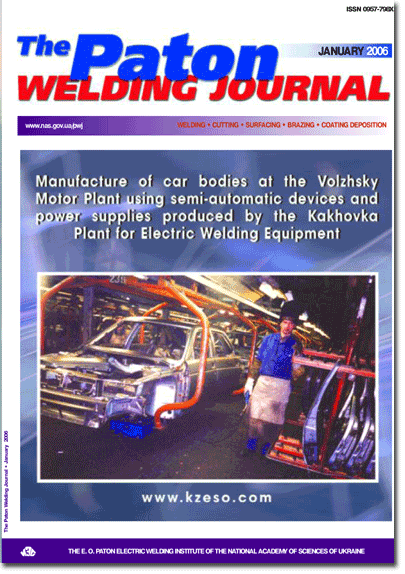

| SCIENTIFIC AND TECHNICAL | |||||||||||||||||||||||||||||||||||||||||||||
| Kuchuk-Yatsenko S.I., Shvets V.I., Gordan G.N., Shvets Yu.V. and Goronkov N.D. Features of formation of structure of joints of rail steel M76 to steel 110G13L made by flash-butt welding | 2 | ||||||||||||||||||||||||||||||||||||||||||||
The paper presents the results of metallographic and X-ray microanalysis of rail steel M76 and steel 110G13L joints, made by pulsed flash-butt welding through an insert of stainless steel 08Kh18N10T.
| Skulsky V.Yu. | Influence of alloying of filler material and welded steel on fusion zone structure 9 |
Features of structure formation in the fusion zone of joints on materials of different alloying systems and pertaining to different structural classes are considered in the case of welded joints made on steels using welding consumables. Depending upon the relationship of temperatures of the solidification range TL„TS of the base and weld metal, partial melting of the grains may develop in the fusion zone, its degree being determined by the differences in the values of these temperatures for the combined materials and cooling of the metal in the near-weld zone. The final structure is influenced by the thermodynamic activity of carbon and its redistribution between the weld and base metal, which also depends on the combined material alloying.
| Markashova L.I., Grigorenko G.M., Ishchenko A.Ya., Lozovskaya A.V., Kushnaryova O.S., Alekseenko T.A. and Chajka A.A. | Effect of scandium additions on structure-phase condition of weld metal produced by welding aluminium alloy 1460 16 |
Microstructure, element and phase compositions of weld metal of the joints produced by arc welding on alloy 1460 using filler wires Sv1201 and Sv1201 + Sc were studied. Main mechanisms of the effect of scandium on structure formation, chemical heterogeneity and mechanical properties of the weld metal were revealed. It is shown that scandium addition leads to grain refining, extra saturation of solid solution with scandium, formation of dispersed particles in the bulk of grains and complex-composition eutectic. The weld metal in this case has an increased strength.
| Lobanov L.M., Pivtorak V.A., Savitsky V.V. and Tkachuk G.I. | Procedure for determination of residual stresses in welded joints and structural elements using electron speckle-interferometry 24 |
A computer program is described for processing the interference fringe patterns in the area of a drilled blind hole, containing information on displacements caused by elastic stress relieving. Experimental and calculated values are given, which were obtained when solving the procedural problem of beam bending under the impact of the specified load. Calculated values were compared with experimental values, this allowing evaluation of the error of the suggested method of stress determination.
| INDUSTRIAL | Knysh V.V., Kuzmenko A.Z. and Vojtenko O.V. | Increasing fatigue resistance of welded joints by high-frequency mechanical peening 30 |
Given are the results of fatigue tests of welded joints treated by strengthening high-frequency mechanical peening right after welding, as well as after operating for 50 % (and more) of their fatigue life. Factors were determined, which promote increase in welded joint fatigue resistance after application of this treatment, namely lowering of stress concentration coefficient, inducing of compressive residual stresses and strain hardening of metal surface layer.
| Zamkov V.N., Vrzhizhevsky E.L., Topolsky V.F. and Petrichenko I.K. | Repair welding of titanium blades of gas turbine engine compressors 34 |
The feasibility was proved of reconditioning repair of the profile part of titanium alloy VT9 blades of gas turbine engine compressors made integral with disks.
| Snisar V.V., Demchenko E.L., Fenogenov A.I. and Vasiliev D.V. | Renovation of bodies of energy-absorbing mechanisms of freight railway cars 39 |
Technology of mechanized arc welding and surfacing without preheating or heat treatment of high-carbon steel 30GSL-B in renovation of bodies of energy-absorbing mechanisms of automatic coupling devices of freight railway cars is presented.
| BRIEF INFORMATION | Kiselevsky F.N., Shapovalov E.V. and Kolyada V.A. | System of laser following of weld reinforcement 42 |
A system of laser following of weld reinforcement has been developed, which is designed for operation as part of an automated ultrasonic testing unit. The system allows performing automatic correction of the US transducer position relative to the reinforcement with the required accuracy.
| Maksimov S.Yu. and Krazhanovsky D.V. | Content of acicular ferrite in weld metal in wet welding 45 |
Influence of weld metal alloying in flux-cored wire underwater welding on the proportion of microstructural components was studied. Possibility of a considerable increase of the share of acicular ferrite in the deposited metal due to its alloying with titanium and boron was established.
| Thesis for a scientific degree | 47 |
| NEWS | 48 | Developed at PWI | 8, | 15, 23, 29, 41, 44 | ||||||||||||
(You are viewing the simplified file contents)
The cost of subscription/purchase order journals or individual articles
| Journal/Currency | Annual Set | 1 issue printed |
1 issue |
one article |
| TPWJ/USD | 384 $ | 32 $ | 26 $ | 13 $ |
| TPWJ/EUR | 348 € | 29 € | 24 € | 12 € |
| TPWJ/UAH | 7200 UAH | 600 UAH | 600 UAH | 280 UAH |
| AS/UAH | 1800 UAH | 300 UAH | 300 UAH | 150 UAH |
| AS/USD | 192 $ | 32 $ | 26 $ | 13 $ |
| AS/EUR | 180 € | 30 € | 25 € | 12 € |
| SEM/UAH | 1200 UAH | 300 UAH | 300 UAH | 150 UAH |
| SEM/USD | 128 $ | 32 $ | 26 $ | 13 $ |
| SEM/EUR | 120 € | 30 € | 25 € | 12 € |
| TDNK/UAH | 1200 UAH | 300 UAH | 300 UAH | 150 UAH |
| TDNK/USD | 128 $ | 32 $ | 26 $ | 13 $ |
| TDNK/EUR | 120 € | 30 € | 25 € | 15 € |
AS = «Automatic Welding» - 6 issues per year;
TPWJ = «PATON WELDING JOURNAL» - 12 issues per year;
SEM = «Electrometallurgy Today» - 4 issues per year;
TDNK = «Technical Diagnostics and Non-Destructive Testing» - 4 issues per year.


